ISSN ONLINE(2319-8753)PRINT(2347-6710)
ISSN ONLINE(2319-8753)PRINT(2347-6710)
| S.K.Dheebika and Dr.R.Kalaivani Department of Electrical And Electronics Engineering, Rajalakshmi Engineering College Affliated to Anna University, Thandalam, Chennai. India. |
| Related article at Pubmed, Scholar Google |
Visit for more related articles at International Journal of Innovative Research in Science, Engineering and Technology
In the recent days, power demand is more than the generation due to huge loads. Hence it is difficult to operate the power system in order to maintain stable power supply. It will lead to major problems like voltage instability and power losses. To overcome these problems, Flexible AC Transmission System (FACTS) have been implemented in power system. Effective results can be obtained by placing these devices in suitable location. In this paper, the location and the ratings of FACTS devices are optimized using Genetic Algorithm (GA). The main objective is to optimize the location and ratings of FACTS devices by considering the three objectives such as the minimization of Voltage Stability Index (VSI), minimization of power losses and minimization of generation cost. Thyristor controlled series capacitor (TCSC) and Static VAR Compensator (SVC) are considered for this project. Genetic Algorithm (GA) is a an iterative method used to provide an optimal solution by solving multi objective optimization problems. The locations and ratings of SVC and TCSC are optimized in IEEE 14 bus and IEEE 30 bus systems using GA. Simulations are done by using MATLAB software. It is clear from the results that the voltage stability is enhanced well and also there is a reduction in power loss by GA when compared with the conventional method.
Keywords |
| voltage stability index; SVC; TCSC; GA. |
| Due to increase in power demand, many power systems are generated and are widely interconnected. As the power transfer grow, it is more complex to maintain voltage at all buses in the power system. Due to some of the reasons like the generating station is locating far away from the load centre, inability to meet the reactive power demand, sudden system condition will lead to voltage instability and losses. Introduction of FACTS devices in suitable location will provide power flow control, reactive power demand, etc. Conventional methods are not suited for multiobjective optimization. Out of many EA techinques GA is used for optimizing the locations of SVC and TCSC because GA is efficient than the conventional method. It can able to provide optimal solution by iterations using genetic operators. Reactive power demand is the main cause for voltage instability as in [1]. The voltage magnitude, phase angle and line impedance of the transmission line as in [2] and [3]. FACTS devices can able to provide control flow, enhance voltage profile as in [4]. FACTS devices are able to enhance the performance of power system as in [5]. FACTS devices can be optimally located by GA and thus voltage stability and static security margin can be increased as in [6]. GA can be optimize the location, type and the rated value of the devices as in [7]. SVC is optimally located by GA with Particle Swarm Optimization to reduce the generation cost and to increase the power transfer capacity which proves that GA is efficient with other algorithm as in [8]. Multitype FACTS devices are optimally located to reduce losses and to increase the security margin by GA as in [9]. FACTS devices are used to solve the optimal power flow problems by placing it in an optimal location as in [10], [11], [12] and [14]. TCSC can able to do congestion management when their location and ratings are optimized as in [15] and [18]. The location and ratings of FACTS devices were optimized by GA and the system loadability and minimization of power losses as in [17]. The location and the control variable settings of TCSC are optimized and the system performance was enhanced and the powerflow in a transmission line was improved as in [19]. From the overview of literature survey, it is clear that FACTS devices has provided versatile benefits and the system performance can be improved drastically when compared without FACTS devices in the system. This paper gives the application of GA to find the location and ratings of TCSC and SVC optimally to enhance the voltage stability, reduce the power losses and the generation cost than the conventional methods. |
PROBLEM FORMULATION |
| A multi-objective optimization problem consists of multiple objective functions with equality and inequality constraints to be optimized. The equality constraints represents the typical load flow equations. The inequality constraints represent the operating limits of the TCSC and SVC. Here, a problem with three objective functions is formulated which include the minimization of VSI, minimization of real power loss and minimization of generation cost. Better results can be obtained by minimizing all the objective function and to satisfy all the constraints. |
| A. Voltage stability index, F1 (Constant) |
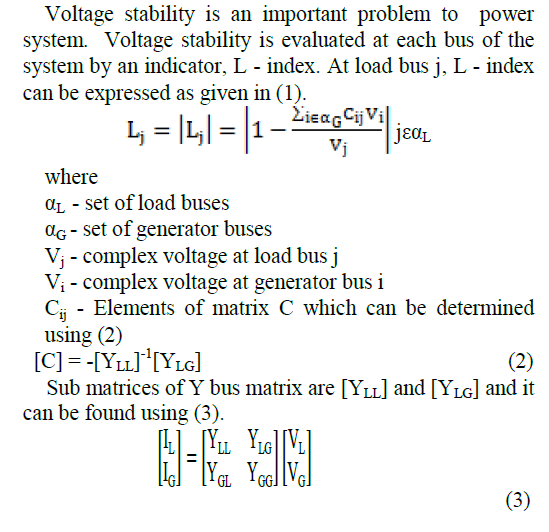 |
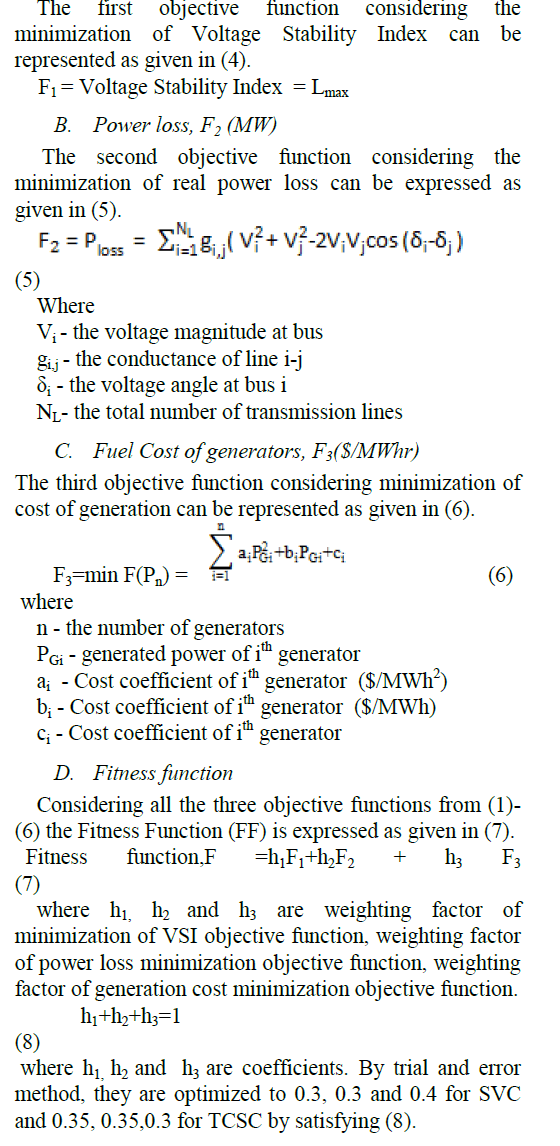 |
FACTS DEVICE |
| In 1988, Hingorani defined the FACTS concept. FACTS devices can able to control the various electrical parameters such as the voltage magnitude at chosen buses, the phase angle and line impedances of transmission line. They will provide advantages such as control of power flow, avoiding blackouts, improving voltage stability, limiting short circuit currents, etc; The four categories of FACTS namely series, shunt, series-series and combined series shunt controllers. A series controller (TCSC) and a shunt controller (SVC) are deal in this paper. |
| A. Power flow modelling of SVC |
| A shunt connected device, SVC which consists of a Thyristor Controlled Rectifier (TCR) in parallel with a bank of capacitor. It regulates the voltage magnitude at which it is connected by either generating or absorbing the reactive power. It is mainly used to provide fast reactive power and voltage regulation support. The basic SVC model is shown in Fig 1. |
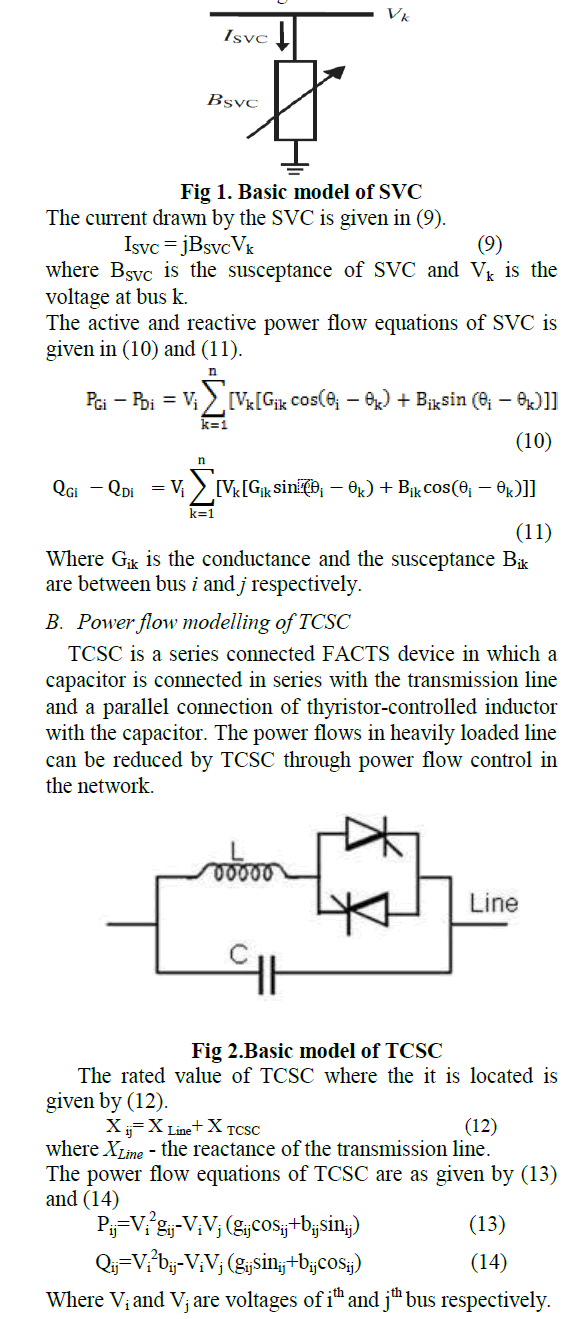 |
GENETIC ALGORITHM |
| GA is a search heuristic method based on the Darwinian theory of the fittest which was developed by John Holland in 1970. It is an iterative procedure used to provide optimal solutions by solving multiobjective optimization problems. |
| At each step of iteration, the individuals are selected randomly from the current population to be parents and the next generation is formed by those parents. Optimal solution can be obtained in repeated iterations. GA can be used to solve to optimization problems with a variety of objective functions even it is highly non-linear, nondifferentiable or discontinuous,. New generation can be obtained through the genetic operators. |
| COMPONENTS OF GA |
| The major components of GA are required to create the new generation from the current population as follows: |
| a) Initial population |
| GA starts with a large group of randomly selected chromosomes knows as initial population. The initial population is created by using the following parameters: NFACTS, Nlocation, Ntypes represents the the number of FACTS devices, the possible location of the devices, the types of devices respectively. |
| b) Selection |
| Selection selects the parents with high fitness from the current population and insert them in a mating pool to create new offsprings. Some of the selection procedures are stochastic, uniform, remainder, roulette wheel, Tournament, rank selection, steady state selection, etc. |
| c) Crossover |
| Crossover plays a major role in convergence speed of GA. After selecting the parents with higher fitness, select an appropriate site to perform recombination process and the contents to the right of the site is exchanged. Some of the crossover schemes are scattered, Intermediate, arithmetic, single point, multipoint or uniform crossover have been used. |
| c) Mutation |
| Mutation operator prevents the premature stopping of the algorithm. It changes a random bit value in a chosen string involves flipping it, changing 0 to 1 and vice versa with a low probability. Gaussian, uniform, adaptive feasible are some of the options of mutations. Mutation probability specifies how often parts of chromosomes will be mutated. |
| A. STEPS IN GA |
| SVC and TCSC are to be placed in IEEE 14 bus and IEEE 30 bus systems by GA, the following steps are to be followed : |
 |
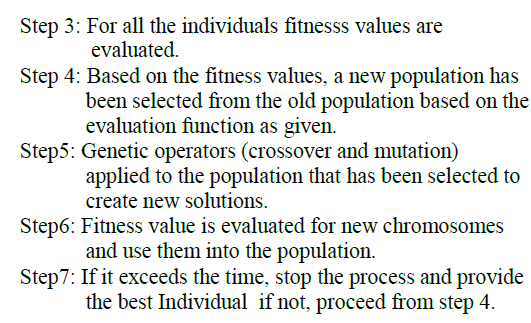 |
RESULTS AND DISCUSSION |
| IEEE 14 bus and IEEE 30 bus systems was used for the tests by GA and the results were obtained. In which the location and ratings of SVC and TCSC were optimized and the objectives such as VSI, power losses and generation cost were minimized. The parameters used by GA is shown in TABLE I. This proves that the GA is more efficient than the conventional method. |
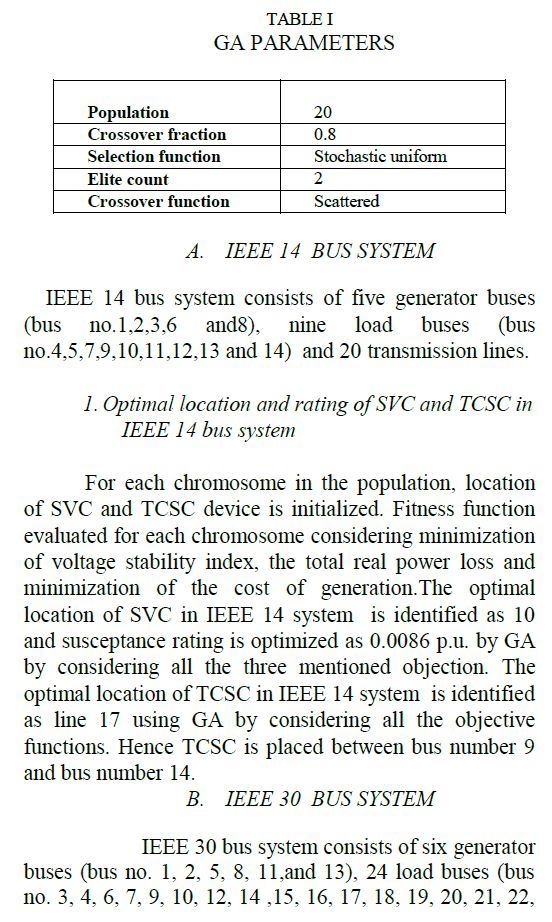 |
| 23, 24, 25, 26, 27, 28, 29 and 30) and 41 transmission lines. |
| 1. Optimal location and rating of SVC and TCSC in IEEE 30 bus system |
| The optimal location of SVC in IEEE 14 system is identified as 24 and susceptance rating is optimized as 0.0692 p.u. by GA by considering all the three mentioned objectives. The optimal location of TCSC in IEEE 30 system is identified as line 36 using GA by considering all the objective functions. Hence TCSC is placed between bus number 28 and bus number 27. |
| A. COMPARISON OF VOLTAGE Profile in IEEE 14 BUS AND IEEE 30 BUS SYSTEMS |
| The enhancement of voltage stability in IEEE 14 bus system is shown in Fig 2. It is observed that voltage profile by GA is enhanced well when compared with the conventional method. |
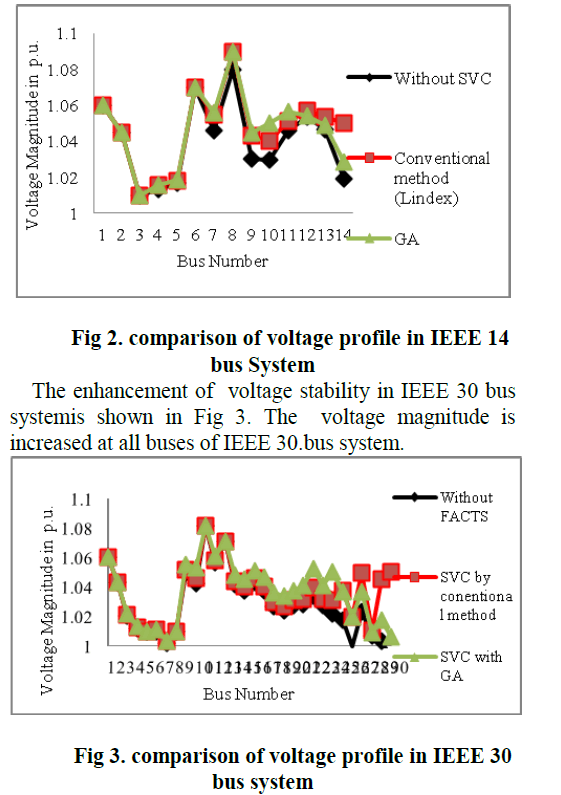 |
| A. COMPARISON OF OBJECTIVE FUNCTIONS IN IEEE 14 BUS SYSTEM |
| The comparison of minimization of VSI, minimization of real power loss and minimization of generation cost are shown in Fig 4 - Fig 6. |
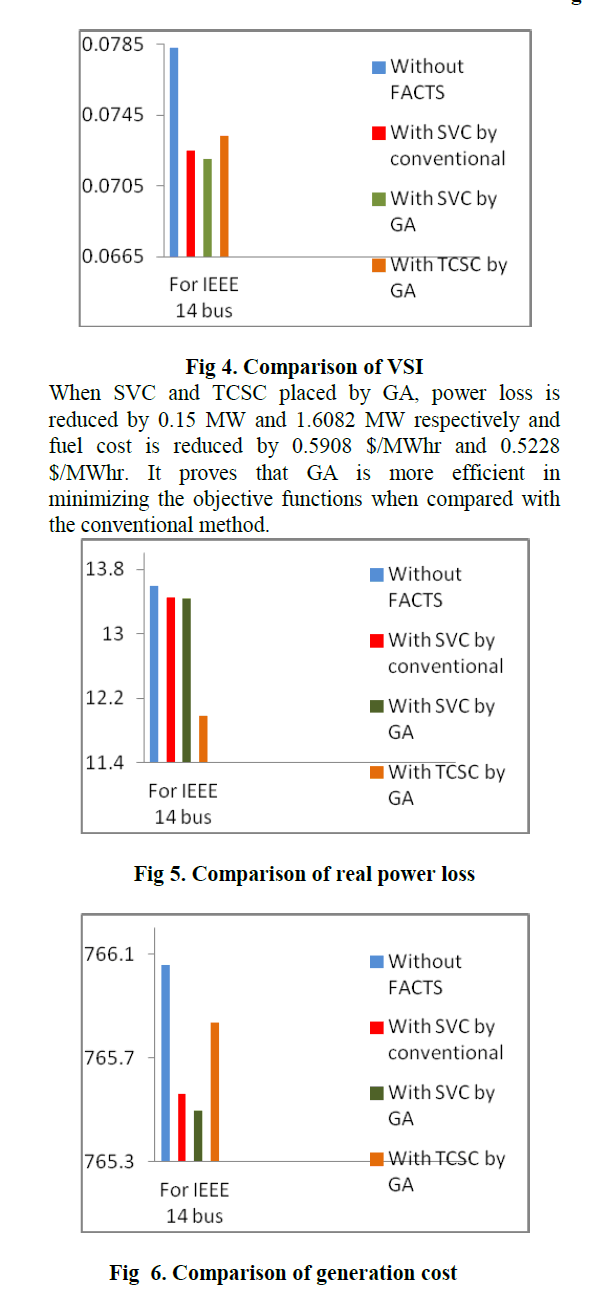 |
| A. COMPARISON OF OBJECTIVE FUNCTIONS IN IEEE 30 BUS SYSTEM |
| The comparison of minimization of VSI, Power loss and generation cost are shown in Fig 7 - Fig 9. When SVC and TCSC placed by GA, power loss is reduced by 0.057 MW and 5.5862 MW respectively and fuel cost is reduced by 0.2254 $/MWhr and 0.0564 $/MWhr. It proves that GA is more efficient in minimizing the objective functions when compared with the conventional method. |
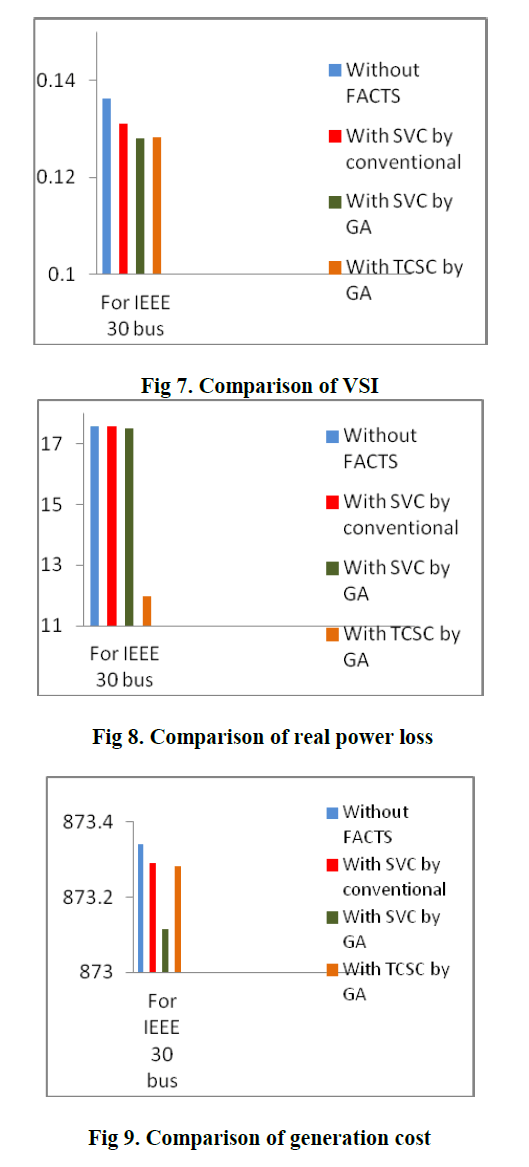 |
CONCLUSION |
| Recently power losses and voltage instability problems are the major problems in power system and generation cost also goes high. FACTS concept made a revolution in power system which overcomes all the problems. Many techniques are used to optimize the location of FACTS devices. GA belongs to a class of Evolutionary Algorithms is used as an optimization technique in this project. The location and ratings of SVC and TCSC are optimally identified by GA and compared with the conventional, NR method. The results shows that voltage profile is enhanced at all buses and power losses are considerably decreased by considering the objectives such as minimization of VSI, minimization of power losses and minimization of generation cost. Thus it proves that the efficiency of GA is better than the conventional method. |
References |
|